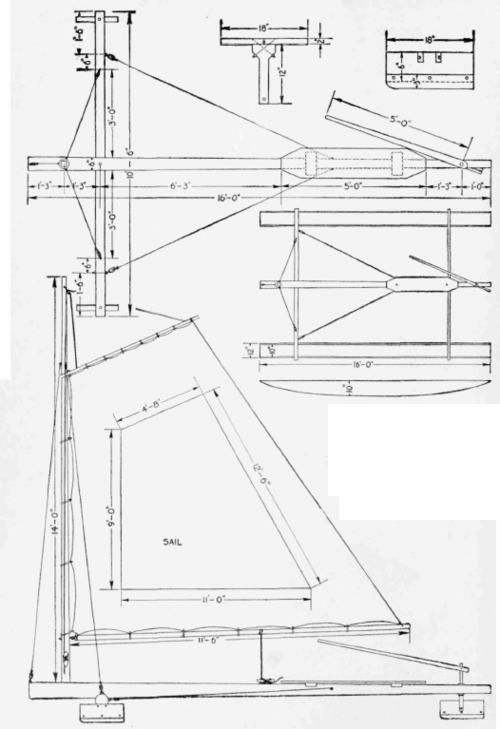An Ice Boat And Catamaran
Description
This section is from the book "The Boy Mechanic Vol. 2 1000 Things for Boys to Do", by Popular Mechanics Co.. Also available from Amazon: The Boy Mechanic, Vol2: 1000 Things for Boys to Do.
An Ice Boat And Catamaran
By Robert K. Patterson
This combination is produced by using the regular type of ice boat and substituting boats for the runners, to make the catamaran.
In constructing the ice boat, use two poles, or timbers, one 16 ft. and the other 10 1/2 ft. long, crossed at a point 2 1/2 ft. from one end of the longer timber. The crossed pieces are firmly braced with wires, as shown.
The mast, which should be about 12 ft. long, is set into a mortise cut in the long timber, 15 in. from the front end, and is further stabilized by wires, as shown. A jib boom, about 6 ft. long, as well as a main boom, which is 11 1/2 ft. long, are hung on the mast in the usual manner.
The front runners consist of band-iron strips, 18 in. long, 3 in. wide, and 1/8 in. thick, with one edge ground like the edge of a skate, and the ends rounding, which are fastened with bolts to the sides of wood pieces, 18 in. long, 6 in. wide, and 2 in. thick, allowing the ground edge to project about 1 inch.

Ill: The Ice Boat Provides an Ideal Outing in Winter Where There Is a Body of Water Large Enough for Sailing
When the ice-boat frame is made of poles, the runners are attached to a piece of wood, 12 in. long, shaped as shown and fastened at right angles with bolts running through the shouldered part diagonally. This makes a surface on which the pole end rests and where it is securely fastened with bolts. If squared t i mbers are used, the runners can be fastened directly to them. The rear, or guiding, runner is fastened between two pieces of wood, so that i t s edge projects; then it is clamped in a bicycle fork, which should be cut down so that about 3 in. of the forks remain. A hole is bored through the rear end of the long pole to receive the fork head, the upper end of which is supplied with a lever. The lever is attached to the fork head by boring a hole through the lever end at a slight angle to fit the head, allowing sufficient end to be slotted, whereupon a hole is bored through the width of the handle, and a bolt inserted, to act as a clamp.

Ill: The Ice-Boat Details, Showing Construction with Straight Poles Having Detachable Runners So the Boats can be Supplied in Their Stead to Make a Sailing Catamaran for Use in Summer
A board is fastened on two cross-pieces mortised in the upper part of the pole, for a place to sit on when driving the boat. The sail can be constructed of any good material to the dimensions given.
To rig up the ice boat for use as a catamaran, place a pole across the stern, the length of the pole being equal to the one used on the front part of the ice boat. Two water-tight boats are constructed, 16 ft. long, 12 in. wide, and 10 in. deep at the center. To make these two boats procure six boards, 16 ft. long, 10 in. wide, and 1 in. thick. Three boards are used to make each boat. Bend one board so that it will be in an arc of a circle, then nail on the two side boards, after which the edges of the sides are cut away to the shape of the bent board. The runners are removed from the ice boat, and the boats fastened to the pole ends. A rudder is attached in the place of the rear, or guiding, runner. The tops of the boats, or floats, can be covered and made water-tight.
Continue to:
More:
- A Mirror an Aid in Rowing a Boat
- Ironing-Board Holder
- Developing Tray Made of a Tin Can
- A Pencil-Sharpener Stick
- How To Make An Electric Heater
- How to Make a Wing Nut


